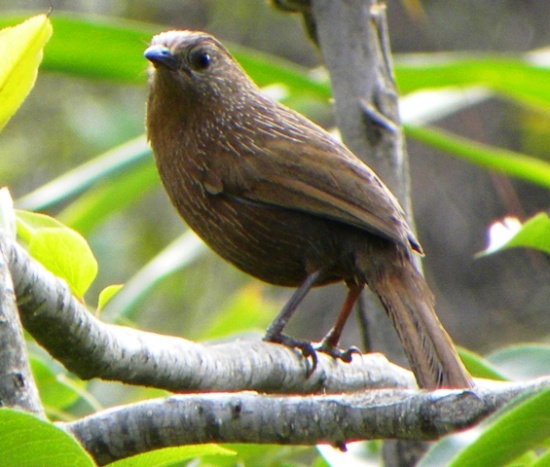m (→Taxonomy) |
Sbarnhardt (talk | contribs) (Add Gsearch checked template) |
||
| (4 intermediate revisions by 3 users not shown) | |||
| Line 1: | Line 1: | ||
| − | ;[[:Category: | + | [[Image:Bhutan Laughing Thrush.JPG|thumb|550px|right|Photo by {{user|BhutanBirds|BhutanBirds}}<br />East [[Bhutan]], May 2012]] |
| + | ;[[:Category:Trochalopteron|Trochalopteron]] imbricatum | ||
==Identification== | ==Identification== | ||
18 - 20cm. A small laughingthrush. | 18 - 20cm. A small laughingthrush. | ||
| Line 6: | Line 7: | ||
* Pale brown ear-coverts and lores, rufescent wings and tail edgings | * Pale brown ear-coverts and lores, rufescent wings and tail edgings | ||
* Broad pale grey tail-tips beyond black subterminal bands | * Broad pale grey tail-tips beyond black subterminal bands | ||
| + | |||
==Distribution== | ==Distribution== | ||
Found in [[Bhutan]], northeast [[India]] (Arunachal Pradesh) and adjacent southern [[Tibet]]. | Found in [[Bhutan]], northeast [[India]] (Arunachal Pradesh) and adjacent southern [[Tibet]]. | ||
Common in most of its range. | Common in most of its range. | ||
==Taxonomy== | ==Taxonomy== | ||
| − | This is a [[Dictionary_M- | + | This is a [[Dictionary_M-O#M|monotypic]] species.<br /> |
It was formerly included in [[Streaked Laughingthrush]] but differs in plumage and vocalization.<br /> | It was formerly included in [[Streaked Laughingthrush]] but differs in plumage and vocalization.<br /> | ||
| − | This species is sometimes placed in the genus [[:Category: | + | This species is sometimes placed in the genus [[:Category:Garrulax|Garrulax]] or in [[:Category:Strophocincla|Strophocincla]]. |
| + | [[Image:Bhutanlt.jpg|thumb|550px|right|Photo by {{user|BhutanBirds|BhutanBirds}}<br />East [[Bhutan]]]] | ||
==Habitat== | ==Habitat== | ||
| Line 22: | Line 25: | ||
Resident species with some altitudinal movements in harsh winters. | Resident species with some altitudinal movements in harsh winters. | ||
==References== | ==References== | ||
| − | #{{Ref- | + | #{{Ref-Clements6thAug13}} |
| + | #Avibase#{{Ref-HBWVol12}}#{{Ref-RasmussenAnderton05}} | ||
{{ref}} | {{ref}} | ||
==External Links== | ==External Links== | ||
| − | {{GSearch| | + | {{GSearch|Trochalopteron+imbricatum}} |
| − | + | {{GS-checked}} | |
| − | [[Category:Birds]] [[Category: | + | [[Category:Birds]] [[Category:Trochalopteron]] |
Latest revision as of 18:14, 15 January 2022
- Trochalopteron imbricatum
Identification
18 - 20cm. A small laughingthrush.
- Dark maroon-brown plumage
- Narrow shaft-streaks over most of plumage except vent and rump, unstreaked brown cap
- Pale brown ear-coverts and lores, rufescent wings and tail edgings
- Broad pale grey tail-tips beyond black subterminal bands
Distribution
Found in Bhutan, northeast India (Arunachal Pradesh) and adjacent southern Tibet. Common in most of its range.
Taxonomy
This is a monotypic species.
It was formerly included in Streaked Laughingthrush but differs in plumage and vocalization.
This species is sometimes placed in the genus Garrulax or in Strophocincla.
Habitat
Bushes and scrub on hillsides and open forest, forest edge, around human habitation, field borders, gardens. Found from 1400m to 3900m.
Behaviour
Feeds on insects, berries, fruits and seeds. Will occasionally also take breadcrumbs.
Very conspicuous and a garden bird in many towns and villages, especially in the western Himalaya. Forages on the ground in pairs or small groups of 3 to 6 birds.
Breeding season from March to October. The nest is a loose, untidy cup made of coarse dry grasses, fine plant stems, dead leaves, plant bark, creepers, dry twigs, fern and moss. It's placed in a thick bush or low in a tree, sometimes also in grass or even in honeysuckle on house verandah. Lays 2 - 4 eggs. The nest is often parasitized by Jacobin Cuckoo, Large Hawk-Cuckoo and Indian Cuckoo.
Resident species with some altitudinal movements in harsh winters.
References
- Clements, J. F., T. S. Schulenberg, M. J. Iliff, B.L. Sullivan, C. L. Wood, and D. Roberson. 2013. The eBird/Clements checklist of birds of the world: Version 6.8., with updates to August 2013. Downloaded from http://www.birds.cornell.edu/clementschecklist/download/
- Avibase#Del Hoyo, J, A Elliott, and D Christie, eds. 2007. Handbook of the Birds of the World. Volume 12: Picathartes to Tits and Chickadees. Barcelona: Lynx Edicions. ISBN 978-8496553422
- Rasmussen, PC and JC Anderton. 2005. Birds of South Asia: The Ripley Guide. Barcelona: Lynx Edicions. ISBN 978-8487334672
Recommended Citation
- BirdForum Opus contributors. (2024) Bhutan Laughingthrush. In: BirdForum, the forum for wild birds and birding. Retrieved 30 April 2024 from https://www.birdforum.net/opus/Bhutan_Laughingthrush
External Links
GSearch checked for 2020 platform.





